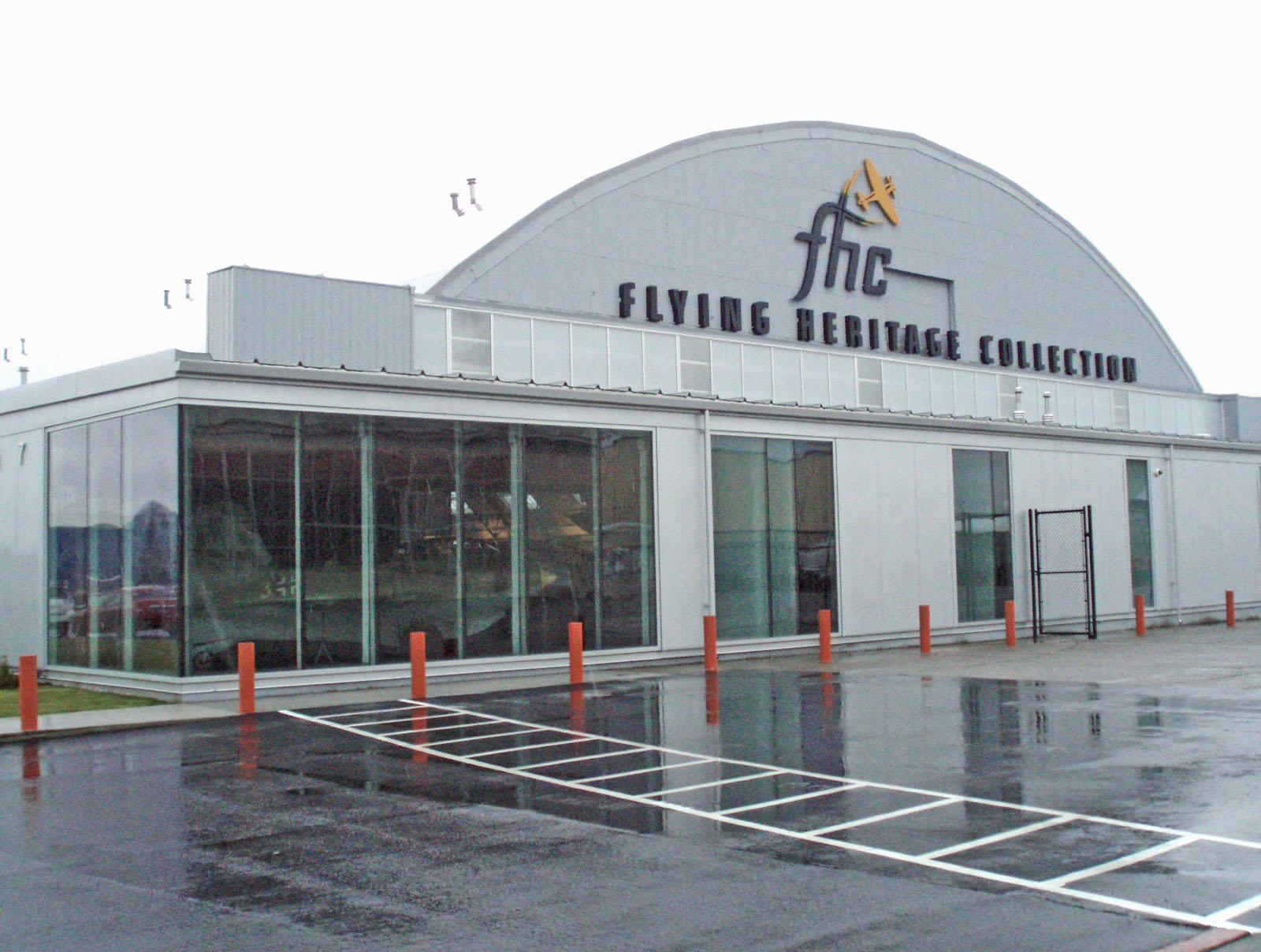By Terry Stephens
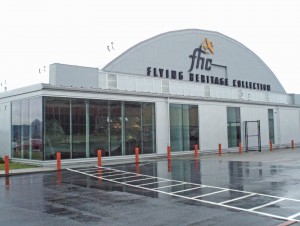
Paul Allen’s Flying Heritage Collection is showcased in this renovated 1950 hangar at Paine Field. The Messerschmitt Me-163B Komet in the window is the world’s first rocket-powered aircraft.
One of the world’s rarest collections of flight-ready World War II warbirds opened at Paine Field (PAE) north of Seattle on June 6, compliments of Microsoft co-founder, philanthropist and aviation enthusiast Paul Allen. Sure to attract global visitors, Allen’s Flying Heritage Collection includes 15 historic battle planes flown by the major participants in the war, including the U.S., Great Britain, Russia, Germany and Japan.
“These rare aircraft can now be seen and enjoyed by anyone with a love of flying, history or technology,” said Adrian Hunt, executive director of the Flying Heritage Collection. “We’re thrilled to open the collection to the public on the 64th anniversary of D-Day. Many of our aircraft are the last examples known to exist. Now, we have a public facility in which to display them.”
Each plane is restored to the highest level of authenticity that money and technology can provide, Hunt said. Assembled records of each plane’s role in aviation history showed researchers that most of them are combat veterans. Even their pilots’ names are part of the meticulous research Allen ordered in preparing his collection.
Grinning in anticipation as the doors of the 1950-vintage hangar rolled apart, Allen led a small contingent of government officials and news media into the restored facility an hour before its official public opening. Walking past row after row of the planes he’d paid untold millions of dollars to find, restore and preserve, Allen chatted admiringly about his P-51 Mustang, P-40 Tomahawk, Japanese Zero, German Messerschmitt 109, British Spitfire and all the others.

On opening day, June 6, billionaire philanthropist Paul Allen toured the Paine Field hangar that’s the new home for his private, multimillion-dollar warbird collection.
“My father was among the troops going into Omaha Beach at Normandy 64 years ago,” Allen said. “I’ve been fascinated by airplanes since I was a boy growing up in Seattle. I’m also fascinated by how they work and by the people who worked so hard to find the answers to improve these planes.”
He said all of the planes on display represent important technology advancements.
“They’re important pieces of aviation history, and this is a great new home for them,” he said. “I hope people will come to see the collection and learn from it.”
Rare planes will fly often
As priceless as they are, Allen wants his planes to fly regularly so people can experience seeing them in their natural element, not just as static displays. Every other Saturday, from June 14 until Oct. 11, a variety of the historic aircraft will take to the skies from noon to 1 p.m. for short flights.
Flying rare warbirds demands rare pilots. Only the most experienced aviators climb into those cockpits, said Hunt. Two of Allen’s pilots include Reno air racer and movie pilot Steve Hinton and Pacific Northwest air show performer Bud Granley, a former RCAF and airline pilot.

This Polikarpov U2/PO-2 biplane, flown as a night bomber by the first women combat pilots, harassed German forces so much they were called the “Night Witches.”
Each aircraft is displayed with interpretive movies and wall displays showing its place in the international, social, political, technological and economic context of its time, Hunt said.
“The Flying Heritage Collection uses planes to show how innovations of the past have impacted modern aviation and aerospace technologies,” he said. “The collection honors not only the planes, but also the pilots who flew them, and the engineers, designers and builders who produced such superb aircraft.”
The exhibits display the dramatic changes occurring in aviation from 1935 to 1945, a time when global war needs created a competitive push for constant innovation and technological advances. The planes represent changes in airframes from wood and fabric to metal planes with retractable landing gears. Engines and superchargers enabled planes to fly higher and faster. With more power, they were able to be equipped with more guns, bombs and armor. The great need by all of the major countries for greater production rates brought about major changes in building methods and materials.
As the demand for support technology grew as well, those years produced innovative developments in communications, navigation, instrumentation and radar. Planes became more reliable and able to fly long distances, even in harsh weather, and conduct complex missions with precise accuracy, as the FHC’s literature describes it.

Germany’s Fiesler Fi-156-C2 “Storch” (foreground) displayed amazing short takeoff and landing abilities, rescuing Italian dictator Benito Mussolini from a mountain ridge during WWII.
One of the guests at the event was Harrison “Bud” Tordoff, 82, a retired U.S. Army Air Corps captain who flew the same P-51 displayed at the FHC exhibit. As a young lieutenant, he flew bomber escort for daylight raids against German forces throughout occupied Europe. As Allen’s FHC researchers traced the history of their plane during restoration, they discovered its link to Tordoff, and reunited him with his original aircraft in 2003. A video of that event is part of the FHC website.
Allen’s teams of searchers found many of the aircraft in a variety of extreme environments and circumstances. The Hayabusa Japanese fighter plane was found deep in the jungles of Papua New Guinea. The P-40C turned up in a Russian field where it had been for five decades after crashing during the war. The V-1 “Buzz Bomb” was found on the floor of a secret underground factory in Germany. The rare Me-109 was discovered in 1988 when a man walking on a beach near Calais, France, tripped on a piece of metal buried in the sand. Connected to that piece, it turned out, was an entire German fighter plane.
Warbird collection spans 1935-1945
In addition to most of the planes displayed on a very limited schedule for three years in two hangars at Arlington Municipal Airport (AWO), four others are now included at the Paine Field air museum. The present display includes:
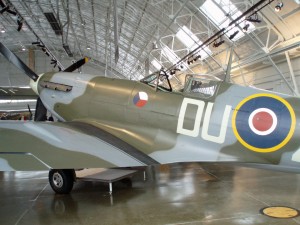
Defending England in the Battle of Britain, the Spitfire is credited with Hitler’s first air combat defeat of the war. The leader of a “Free Czech” squadron flew this plane.
North America P-51D Mustang: Built in 1945, the plane’s incredible range made it a perfect escort for American bombers. Deadly, fast, high-flying and fuel-efficient, Mustangs destroyed more aircraft than any other fighter in the European Theater. Although many of the popular planes still fly frequently at air shows, this particular plane is considered to be the most authentic example of the P-51D left in the world.
British Supermarine Mk.Vc Spitfire: In the Battle of Britain, the Spitfire provided air defenses during Germany’s bombing of London, providing Hilter’s first air combat defeat of the war. The leader of a “Free Czech” squadron used Allen’s aircraft, built in England in 1940, for escorting allied bombers over occupied France.
Curtiss P-40C Tomahawk: The P-40, known as the Warhawk in U.S. service, was immortalized by its outstanding service in China with pilots of the American Volunteer Group, better known as the Flying Tigers. Allen’s restored aircraft was used extensively in European combat, defending Murmansk, Russia, from German forces. Disabled in a dogfight, the plane survived a wheels-up landing on the Russian front, where it rested for decades until its recovery in 1993. Today it’s the only known original P-40 in flying condition.
Curtiss JN-4D Jenny: The first aircraft to be mass-produced in the United States, the Jenny never saw combat but trained American and Canadian pilots for service in World War I. Some of aviation’s most famous flyers learned to fly in the Jenny, including Charles Lindbergh, Jimmy Doolittle and Amelia Earhart.
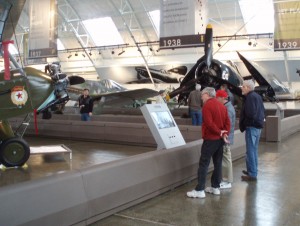
Visitors watch the video story of the Russian “Night Witches” who flew the PO-2 biplane against the Germans. Behind the group is a Grumman Hellcat, the star of the Navy’s Pacific Theater air war.
Russian Polikarpov I-16, Type 24: The world’s first low-wing monoplane fighter with retractable land gear, developed in the early 1930s, this plane supported Republican forces in the Spanish Civil War, fought against the Japanese in Mongolia and defended Russia during WWII.
Russian Polikarpov U-2/PO-2: Used as a trainer and scouting aircraft, this WWII biplane served two generations of Russian pilots. During the war, it was deployed as a courier, ambulance, general transport and bombing aircraft. Russia’s “Night Witches,” as the Germans called the young women in their teens and 20s who flew night missions to drop bombs on sleeping Nazi forces, flew the PO-2. The plane is one of very few remaining specimens.
Fiesler Fi 156-C2 Storch: The only one of his planes that Allen has flown in, the Storch is known for its unrivalled ability to take off and land in extremely small spaces. That capability allowed German Special Forces to rescue Italian dictator Benito Mussolini in a daring daytime raid on a small mountain plateau. It also delivered the infamous suitcase bomb to the site of the attempted assassination of Adolph Hitler.
Grumman F6F-5 Hellcat: The backbone of American aircraft carrier groups during WWII, the Hellcat was the most-produced fighter aircraft in history and the best general-purpose fighter plane in the Pacific Theater. Allen’s rare model is on display but awaiting restoration.
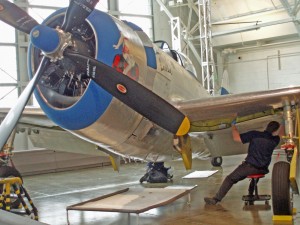
A mechanic working on this P-47 Thunderbolt is a common sight at the Flying Heritage Collection. Most of the planes are in flying condition and need periodic maintenance and care.
Nakajima Ki-43-1c Hayabusa (Oscar): Early in WWII, this aircraft was the Japanese Army Air Force’s primary fighter, capable of tight turns with a lift ratio other planes couldn’t match. Allen’s aircraft, built in Japan in 1942, was found in the jungle of Papua, New Guinea, after the ceasefire. It’s the only known complete, privately owned, original Hayabusa in the world.
Mitsubishi A6M5 Zero-Sen: Perhaps the best-known combat aircraft associated with its nation of origin, the Zero-Sen was Japan’s light carrier fighter. With incredible range, it ruled the skies over Asia and the South Pacific from 1940 to early 1942, outperforming any American plane in that region at the time. It was used as escorts for Kamikaze bomber aircraft and later became a Kamikaze weapon itself. On display in a restoration area of the hangar, the plane will eventually become another flyable warbird in Allen’s collection.
Messerschmitt Bf 109E-3 Emil: Mating of the most powerful engine available with the smallest possible airframe for maximum performance produced one of the most deadly of German fighter planes. It’s one of only two flying examples of this plane in the world. It’s generally regarded as the most significant fighter plane of WWII, with a major role in the Battle of Britain.
Hawker Hurricane Mk. XIIB: Because of its simplicity and adaptability, the Hurricane served in every major theater of air warfare in WWII. Although the Supermarine Spitfire is more famous for winning the Battle of Britain against German fighters, the Hurricane destroyed more enemy planes, primarily targeting bombers.
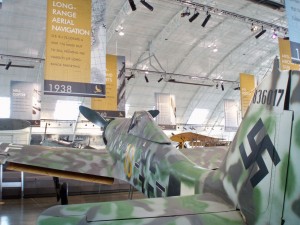
This Focke-Wulf Fw 190D-13 Dora is flyable but so rare that it will be kept on the ground. Superior to the British Spitfire, it was heavily armed with four 20-mm cannons and two 13-mm machine guns.
Focke-Wulf Fw 190D-13 Dora: This famous plane is in flyable condition but so rare that it’s not on the museum’s “fly list.” Superior to the British Spitfire, it was also more heavily armed, with four 20-mm cannons and two 13-mm machine guns. Later versions added a 30-mm cannon that fired through the propeller hub, helping the plane to live up to its nickname, “Butcher Bird.” It’s the only long-nosed version of this plane to survive the war.
Messerschmitt Me 163B Komet: The world’s first operational rocket-propelled aircraft, the Komet was designed to destroy high-altitude bombers. Remarkably agile at higher speeds, it was difficult to fly at slower speeds. A major technological breakthrough, the plane was powered by an extremely volatile Walter rocket engine that exhibited a tendency to explode in flight.
Republic P-47D Thunderbolt: Powered by the largest Pratt & Whitney engine ever developed at that time, the Thunderbolt was equipped with eight .50-caliber machine guns and heavy armor. One of the largest fighter planes ever built, it also was one of the toughest, helping pilots to return to their base even after their plane was damaged in combat. The FHC’s plane was flown by Col. Ralph Jenkins, a Seattle native who led the 510th Fighter Squadron during the war.
First cruise missiles featured
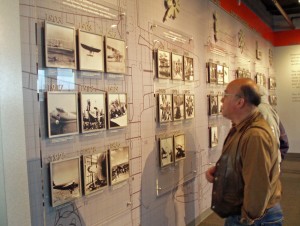
A wall of photos at the entrance to Allen’s collection depicts technology advances in aviation decade by decade.
The collection also includes three non-flying historical artifacts, including a rocket-powered German Fiesler Fi 103/V-1 “Buzz Bomb,” the world’s first cruise missile. It was built at the Nordhausen munitions factory inside the Harz Mountains by slave labor from the Buchenwald concentration camp. The Germans fired thousands of these flying bombs at London.
A Fiesler Fi-103R “Reichenburg” is even rarer. The pilot of this manned version of the V-1 was supposed to bail out as he aimed at his target, but the rocket craft never flew in combat.
The nose and cockpit of an Avro Lancaster B, Mk.1 British bomber offers an inside look at the cramped space crews had available. The famous plane sank the Tirpitz, sister ship to the Bismark. More than 3,000 Lancasters dropped food to the starving Dutch in 1945, near the war’s end.
Other Flying Heritage Collection aircraft in various stages of restoration include a Goodyear FG-1D Corsair, North America B-25J Mitchell, Boeing B-17E Flying Fortress, a jet-propelled Messerschmitt Me 262A-1a Schwalbe, Ilyushin IL-2M-3 Shturmovik, Lockheed P-38J Lightning, Casa 2.111D (Heinkel He 111H), North American F-86A Sabre, Yakovlev Yak-3U, Republic F105G Thunderchief, Vought F-8 Crusader, Mikoyan and Gurevich MiG-21 Mongol, BAE/Hawker GR-3 Harrier and a de Havilland DH98 Mosquito.

On opening day at the Flying Heritage Collection, Harrison “Bud” Tordoff, 82, tells visitors the P-51 behind him is the same plane he flew on bomber escort missions over Europe during WWII.
Eventually, Allen’s display will include a restored German V-2 rocket, the world’s first long-range ballistic missile that Germany used against London and Antwerp in the last months of WWII.
Appropriately, even the 51,000-square-foot Paine Field hangar that houses the rare collection is the result of a restoration project. The $5 million effort provides the planes with a comfortable, roomy and well-lighted facility. But the old hangar, once used by Alaska Airlines as a maintenance facility, lacked many things, including good lighting, when Seattle architect Owen Richards first saw it.
“The windows were covered with old corrugated sheets of plastic,” said Richards, hired by Allen’s Vulcan Inc. to transform the facility into an attractive public venue. “When we put in new windows and replaced those old materials, it really let the light in. Then we polished up the concrete floor and put a poly-membrane coating over the barrel roof.”
The arrival of the Flying Heritage Collection at Paine Field adds yet another major aviation attraction to the airport, joining the Future of Flight Aviation Center, Boeing Tour facility and the Seattle Museum of Flight’s aircraft restoration center. Coming soon will be another significant aviation facility, John Sessions’ Historic Flight at Kilo-6. His flyable planes include a P-51, F7F Tigercat and B-25 Mitchell bomber, just a few of the planes in his Historic Aviation Foundation collection.

Adrian Hunt, the Flying Heritage Collection’s executive director, explains the history of the 1930 Russian Polikarpov I-16 behind him, the first low-wing monoplane fighter with retractable landing gear.
The Flying Heritage Collection and its gift store are open 10 a.m. to 5 p.m. daily from Memorial Day through Labor Day and daily except Monday during the rest of the year.
For more information, visit [http://www.flyingheritage.com].











